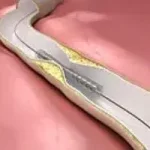Angioplasty & Stent Placement
Click to View Treatments
Angioplasty and Stent Placement – Peripheral Arteries
 Angioplasty is a procedure to open narrowed or blocked blood vessels that supply blood to your legs. Fatty deposits can build up inside the arteries and block blood flow. A stent is a small, metal mesh tube that keeps the artery open. Angioplasty and stent placement are two ways to open blocked peripheral arteries.
Angioplasty is a procedure to open narrowed or blocked blood vessels that supply blood to your legs. Fatty deposits can build up inside the arteries and block blood flow. A stent is a small, metal mesh tube that keeps the artery open. Angioplasty and stent placement are two ways to open blocked peripheral arteries.
Description
Angioplasty uses a medical “balloon” to widen blocked arteries. The balloon presses against the inside wall of the artery to open the space and improve blood flow. A metal stent is often placed across the artery wall to keep the artery from narrowing again.
To treat a blockage in your leg, angioplasty can be done in the following:
- Aorta — the main artery that comes from your heart
- Artery in your hip or pelvis
- Artery in your thigh
- Artery behind your knee
- Artery in your lower leg
Your surgeon will then place a tiny needle into the blood vessel in your groin. A tiny flexible wire will be insertedthrough this needle.
- Your surgeon will be able to see your artery with live x-ray pictures. Dye will be injected into your body to show blood flow through your arteries. The dye will make it easier to see the blocked area.
- Your surgeon will carefully guide a thin tube called a catheter through your artery to the blocked area.
- Next your surgeon will pass a guide wire through the catheter to the blockage.
- The surgeon will push another catheter with a very small balloon on the end over the guide wire and into the blocked area.
- The balloon is then filled with air. This opens the blocked vessel and restores blood flow to your heart.
A stent may also be placed in the blocked area. The stent is inserted at the same time as the balloon catheter. It expands when the balloon is blown up. The stent is left in place to help keep the artery open. The balloon and al the wires are then removed.
Why the Procedure is Performed
Symptoms of a blocked peripheral artery are pain, achiness, or heaviness in your leg that starts or gets worse when you walk. You may not need this procedure if you can still do most of your everyday activities. Your doctor can try medicines and other treatments first.
The risks of angioplasty and stent placement are:
- Allergic reaction to the x-ray dye
- Bleeding or clotting in the area where the catheter was inserted
- Damage to a blood vessel
- Damage to the artery in the groin, which may need urgent surgery
- Kidney failure (higher risk in people who already have kidney problems)
- Misplacement of the stent
